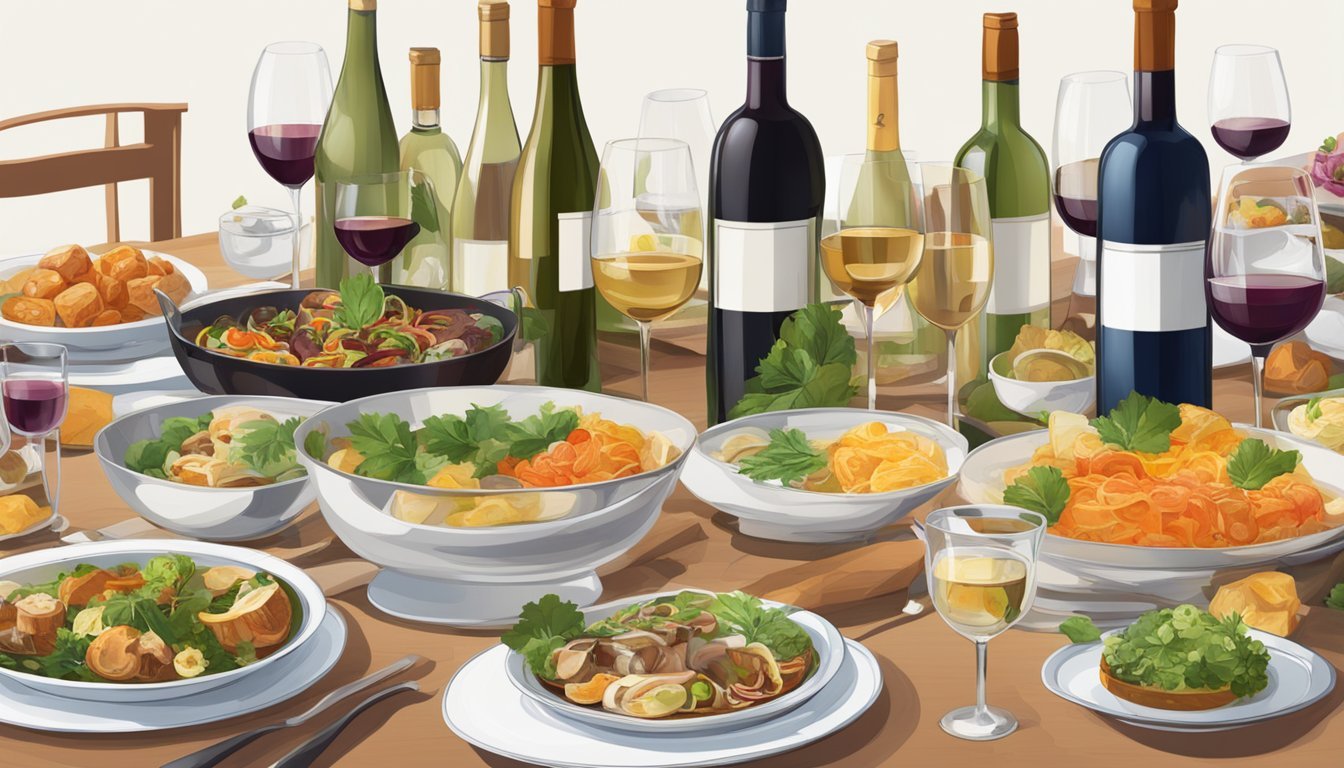What Wine Pairs Best with Umami-Rich Dishes
Expert Selections Revealed
Understanding the complex taste of umami—a savory and meaty flavor found in foods like mushrooms, ripe tomatoes, soy sauce and aged cheeses—poses an intriguing challenge when selecting a complementary wine. Described as the fifth taste, along with sweet, sour, bitter, and salty, umami adds a depth of flavor that can enhance a dish. The key to pairing wine with umami-rich dishes (What Wine Pairs Best with Umami-Rich Dishes) lies in finding a balance that neither overpowers the food nor gets lost on the palate.
White wines with a good balance of acidity and fruity notes can complement umami flavors well. Varieties such as Sauvignon Blanc, off-dry Riesling, and Grüner Veltliner offer a refreshing counterpoint to the richness of umami-heavy dishes. White wines not only pair nicely with Asian cuisine but also with seafood, providing a palate-cleansing effect that enhances the dining experience.
Turning to red wines, those with moderate tannins and a more fruit-forward profile tend to harmonize with umami's savory nature. Wines such as Pinot Noir and Sangiovese have the right structure to mingle with umami without overwhelming it. These reds can bridge the gap between the complex umami flavors and wine, enhancing the overall flavors of the meal.
Understanding Umami
The exploration of umami begins with recognizing it as the fifth fundamental taste, a profound game changer in the culinary world alongside sweet, sour, bitter, and salty.
Origins and Definition
Umami was first identified in Japan by Professor Kikunae Ikeda in the early 20th century. Ikeda pinpointed glutamate, an amino acid, as the source of this savory taste. Subsequently, he succeeded in creating monosodium glutamate (MSG), a compound that enhances this flavor. The term "umami" translates to "pleasant savory taste," and it has since been universally acknowledged as the fifth taste.
Characteristics of Umami in Food
Umami is characterized by its ability to round out the overall flavor profile of a dish. It arises from the presence of glutamic acid and other amino acids, and it tends to make food taste more robust and satisfying. Fermentation and ripening processes in food production often increase the umami characteristic due to the breakdown of proteins into free amino acids and nucleotides.
Common Umami-Rich Foods
Some of the most recognized umami-rich foods include:
Mushrooms: particularly shiitake, known for their high glutamate content.
Tomatoes: concentrated in sun-dried or cooked-down forms.
Cheeses: aged varieties like Parmesan are rich in umami.
Soy sauce: a fermented product that boasts a high level of amino acids.
Seaweed: often used in Asian cuisines to enhance the umami flavor.
These foods act as potent natural sources of umami and elevate culinary dishes by providing a deeper, more complex flavor.
Fundamentals of Wine
Understanding the basics of wine is essential for appreciating its role in complementing umami-rich dishes. The chemistry of wine, its broad categories, and the specialized language used to discuss its characteristics each play a part in its pairing potential.
Wine Composition
Wine is primarily composed of water, alcohol, acids, phenolic compounds such as tannins, and various flavor compounds that are byproducts of fermentation. The balance of these components influences the wine's overall taste and suitability for pairing with different flavors, including umami. For example, tannins, which contribute to the bitterness and astringency of wine, are more prominent in red wines like Pinot Noir, and their interaction with savory dishes can be pivotal in pairing.
Primary Wine Categories
Wines are broadly categorized into red, white, and rosé, with each category containing numerous varietals. Common white wines like Chardonnay, Sauvignon Blanc, and Riesling are known for their acidity and fruitiness. These characteristics often make them complementary to the savory, brothy qualities of umami. On the other hand, red wines, which are sometimes aged to reduce tannin sharpness, may offer a contrasting and complex partner to umami-rich ingredients.
Red Wines: Typically bolder, with flavors ranging from ripe fruits to earthy tones.
White Wines: Usually lighter, with crisp and refreshing profiles.
Rosé Wines: Often a middle-ground with attributes from both red and white wines.
Wine Tasting Terminology
Wine connoisseurs and sommeliers rely on a specific set of terms to describe the flavors, aromas, and overall profile of wines. Understanding this terminology can aid in the proper selection of a wine for any dish. Key terms include:
Acidity: Describes the freshness or tartness.
Sweetness: Often perceived on the tip of the tongue, indicating sugar levels.
Bitterness: Most often associated with tannins in red wines.
Sourness: A reflection of a wine's acidic components.
A solid grasp of these fundamentals positions one to select wines that enhance the depth and richness of umami flavors in food, creating a harmonious dining experience.
Science of Taste
When pairing wine with umami-rich dishes, understanding the science of taste is crucial, as it influences the harmony between food and wine. Taste is not only about the flavor of the food but also how it interacts with the wine, leading to a more complete gastronomic experience.
Five Basic Tastes
The human palate can distinguish five basic tastes: sweet, sour, bitter, salty, and umami. Each taste has a specific role in food perception and pairing:
Sweet: Often balances sourness and bitterness, found in many wines as residual sugar.
Sour: Adds freshness and lift to a dish; may be present in wine as acidity.
Bitter: Can provide complexity, but needs to be balanced to avoid overpowering other tastes.
Salty: Enhances flavors and can soften the bitterness or harshness of tannins in wine.
Umami: Known as the 'fifth taste,' it adds depth and savoriness, often complemented by full-bodied wines.
Influence of Sensory Components on Taste
The interaction of the sensory components of food and wine affects how one tastes and perceives flavors. For example, a wine's acidity can cut through the richness of umami and refresh the palate. Tannins in wine interact with the fats and proteins in food, potentially softening the perception of the wine's astringency. Below is how these components typically influence taste:
Acidity: Increases salivation, sharpens flavors.
Tannins: Can be drying, interact with fats for a smoother mouthfeel.
Alcohol: High levels can create a perception of sweetness and body.
Body of wine: Influenced by alcohol and tannins, it should match the weight of the food.
Taste Buds and Perception
Taste buds play a key role in how flavors are perceived. Each taste bud contains cells that respond to different tastes, which when stimulated, send signals to the brain. The perception of umami, for instance, is often attributed to certain amino acids and nucleotides that stimulate specific taste buds. Subsequently, sensory receptors process the presence of these compounds communicating the overall flavor profile to the brain.
It's important to note that individual perception of taste can vary greatly, meaning wine pairings may be subjective and influenced by one's own taste bud sensitivity and personal preference.
Wine and Food Pairing Principles
When considering food and wine pairings, one must address the harmony of flavors, the impact of seasoning, and the sensory experience of both the wine and the dish.
Balance Between Wine and Dish
The primary objective in pairing umami-rich foods with wine is to achieve a balance of taste where neither the wine nor the dish overwhelms the other. An umami-rich dish, characterized by its depth and savory quality, pairs well with wines that have complementary flavors and sufficient vibrancy to stand up to the pronounced taste of the food.
Impact of Salt and Acidity
Salt enhances the natural flavor of both food and wine, acting as a bridge between the two. Wines with a higher level of acidity can cut through the savory nature of umami, bringing a refreshing contrast. For instance, a crisp Sauvignon Blanc may balance the saltiness and umami of a seafood dish. A table to simplify this pairing is as follows:
Food Characteristic Wine Pairing Salty & Umami-rich High-acidity Wines
Role of Tannins and Texture
The texture of a wine, often dictated by its tannin structure, plays a significant role in pairing. Tannins can interact with the richness of umami flavors found in meat dishes, either complementing or conflicting. It is advisable to opt for wines low in tannins for umami-focused dishes, thus avoiding the risk of an overly astringent taste that might overshadow the food's complexity.
Umami-rich Dish Suggested Wine Meaty & Full-flavored Low-tannin Red Wines
Umami and Wine Interaction
Understanding the interaction between umami-rich dishes and wine enhances the dining experience. This section explains how the distinctive taste of umami presents challenges and opportunities when paired with wine.
Challenges of Pairing Umami-rich Dishes with Wine
Umami, known as the fifth taste, is typically characterized by a savory depth of flavor. Foods rich in umami, such as aged cheeses (What wine goes well with aged cheeses?) and mushrooms, present unique challenges when paired with wine. The distinct savory taste can amplify the bitterness and tannins in red wines and may clash with overly sweet wines. This interaction can lead to an imbalance in the palate where one flavor overpowers the other.
Wine Selection for Umami-rich Cuisine
For umami-rich foods, the key is to select wines that complement the savory flavors without competing with them. Wines that have a pronounced acidity, subtle sweetness, or a certain savoriness themselves tend to pair better with these dishes. White wines like Sauvignon Blanc or off-dry Riesling offer fruity flavors that balance the umami taste. Reds with less tannic profiles, such as Pinot Noir, can also be favorable.
Expert Pairing Recommendations
Experts recommend certain pairings that can create harmony between umami-rich cuisine and wine. Consider these pairing basics:
For seafood with umami richness: a bright Vermentino or Grüner Veltliner complements the taste without overwhelming the flavors.
With Asian cuisine that carries a strong umami character: try an off-dry Riesling that provides a contrast with its sweetness.
For dishes with mushrooms or aged cheeses: a Pinot Noir or Sangiovese can interact well with the earthy notes due to their lower tannins and red fruit characteristics.
These pairings take into account the balance of sour, salty, and bitter elements, accentuating the delicious flavors present in both the food and the wine.
Case Studies: Umami and Wine Pairings
Exploring the harmonious combinations of umami-rich dishes with carefully selected wines leads to a deeper appreciation of flavors in both the food and the beverage. Here are some specific examples showcasing successful pairings across various cuisines and dietary preferences.
Pairing with Asian Cuisine
Asian cuisine often features a pronounced umami character due to ingredients like soy sauce, miso, and seaweed. White wines such as Sauvignon Blanc or an off-dry Riesling complement sushi (What wine goes well with sushi?) and sashimi's delicate flavors. For dishes with more intensity, such as teriyaki-prepared meats or shiitake mushrooms, a glass of light-bodied Pinot Noir respects the dish's complexity while adding a fruity counterpoint.
Japanese Miso Soup: A subtle Grüner Veltliner pairs well with miso's salty-savoriness.
Sushi and Sashimi: Opt for a crisp Vermentino to enhance the fresh flavors of the fish.
Wines for Meat Dishes
When it comes to meat, the umami present can be amplified by selecting the right wine. Heavier meats like braised beef benefit from the soft tannins of aged Barolo or red wines, which balance the rich flavors without overpowering the palate. Alternatively, lighter meats may find their match in medium-bodied reds such as Zweigelt or Corvina, which offer a harmonious blend of fruit and a hint of spice.
Braised Beef: Aged Barolo with softened tannins melds with the savory depth of the dish.
Roast Chicken: Try a mature Chardonnay which can bring out the subtleties of the herbs and spices used.
Vegetarian and Vegan Pairings
For vegetarian and vegan dishes that pack an umami punch, wines don't have to be robust to make an impact. Bright sparkling wines can lift the flavors of green tea-infused tofu or a savoury miso-glazed eggplant. A versatile Champagne serves as a palate cleanser and flavor enhancer for a variety of vegetable-based umami dishes.
Miso-Glazed Eggplant: A light, effervescent Champagne emphasizes the dish's richness without overwhelming it.
Green Tea-infused Tofu: A refreshing sparkling wine provides a pleasant contrast to the earthy taste.
Advanced Wine Knowledge
When pairing wines with umami-rich dishes, aficionados look beyond simple taste profiles to how various elements of a wine evolve and interact with the flavor complexity of food.
Influence of Aging on Wine’s Umami Compatibility
Aged wines typically showcase a more harmonious compatibility with umami flavors due to the softening of tannins and development of more nuanced flavor profiles. This softening occurs because tannins, found in grape skins, diminish over time, reducing bitterness and astringency that might otherwise overwhelm the umami in dishes. For instance, an older Napa Valley Zinfandel might reveal a more mellow fruitiness and spicier undertones, which can complement umami without overpowering the palate. Connoisseurs often rely on aged wines, like complex and mature red wines which include Mourvèdre, Grenache, and Petite Sirah, to balance the savory depth of umami-rich foods.
Wine Aging Period Tannin Softness Recommended Umami Pairing Young High Tannins Lighter Umami Dishes Mature Softened Tannins Complex Umami-Rich Dishes
Trends in Umami and Wine Research
Sommeliers and researchers continue to experiment with umami and wine pairings, paving the way for innovative culinary experiences. For example, Master of Wine Tim Hanni's work suggests that individual sensibilities—like a sensitivity to bitterness or sourness—can affect how one perceives the interplay between wine and umami. Understanding the science behind umami, which arises from amino acids and nucleotides in foods such as mushrooms or aged cheeses, helps professionals predict how these flavors will interact with the compounds in wine.
Recent studies focus on the process of aging on lees (dead yeast cells), which can increase the perception of acidity and complexity in wines. This can counterbalance the richness of umami without introducing unwanted hot spiciness. When wines age on lees, they often develop a creamier texture and greater depth, favorable qualities for pairing with umami-strong dishes.
Research Focus: Lees Aging
Benefit to Wine: Enhanced Acidity & Complexity
Umami Pairing Impact: Balances richness with creaminess
These advanced insights into wine pairings deepen wine lovers' appreciation for both their favorite beverages and the dishes they accompany.
Tips for Experimentation at Home
When exploring umami-rich food and wine pairings at home, a methodical approach can lead to delightful discoveries. Below are some structured tips that homeowners can apply to experiment with different combinations:
Begin with the Basics: Understand that umami refers to the savory taste often attributed to ingredients high in glutamate, such as mushrooms, tomatoes, and aged cheeses. Umami pairs well with wines that balance this richness without overpowering the taste buds.
Selecting Wines: Opt for white wines like Sauvignon Blanc or off-dry Riesling for their fruity flavors that complement umami tastes in Asian cuisines, or choose red wines such as Pinot Noir and Sangiovese that are known to enhance savory dishes.
Pairing Technique: Introduce salt and sugar modestly in dishes to heighten umami. Cooking processes like browning or roasting can also accentuate umami flavors in food.
Mindful Tasting: Take small bites of the umami-heavy food, followed by a sip of wine. Evaluate how they interact on a scale from 1 to 5, where 1 indicates a poor pairing and 5 indicates an excellent match.
Note the Effects: Pay attention to how the wine's taste changes in the presence of umami. Some wines may have their astringency emphasized, while in others, flavors may become more rounded.
Balance Spiciness: For dishes with hot spiciness, seek wines with a touch of sweetness or lower alcohol content to ensure they don't amplify the heat excessively.
Understand Your Taste Receptors: Receptors T1R1 and T1R3 are responsible for detecting umami. Observe how certain pairings might stimulate these receptors differently, changing your perception of the food and drink combination.
Home experimentation not only enhances the dining experience but provides a deeper understanding of one's personal taste preferences and how different elements interact on the palate.
Conclusion
Wine pairing with umami-rich dishes requires a nuanced understanding of flavors. A sommelier might say that balance is key. When a dish boasts umami—often found in foods like aged cheeses, mushrooms, certain meats, and fermented products—selecting the appropriate wine enhances the dining experience.
Red wines, such as Pinot Noir, Zweigelt, and Sangiovese, generally complement these dishes well. They often possess a fruit-forward character that marries with the savory depth of umami.
White wines shouldn't be overlooked for umami pairings. Varietals like Sauvignon Blanc and Riesling offer a bright acidity and fruitiness that can cut through the richness, adding a delicious contrast to umami flavors.
For those who prefer more adventurous pairings, aged wines can be particularly delightful. The tannins soften over time, making them less likely to clash with umami's complexity.
In summary, the perfect wine pairing for umami-rich dishes can elevate the taste experience to new heights. Whether it's a red or white, sommeliers and wine enthusiasts agree that the right wine can turn a flavor profile into a symphony on the palate. It's the harmonious interplay between wine and food that brings out the best in both.










